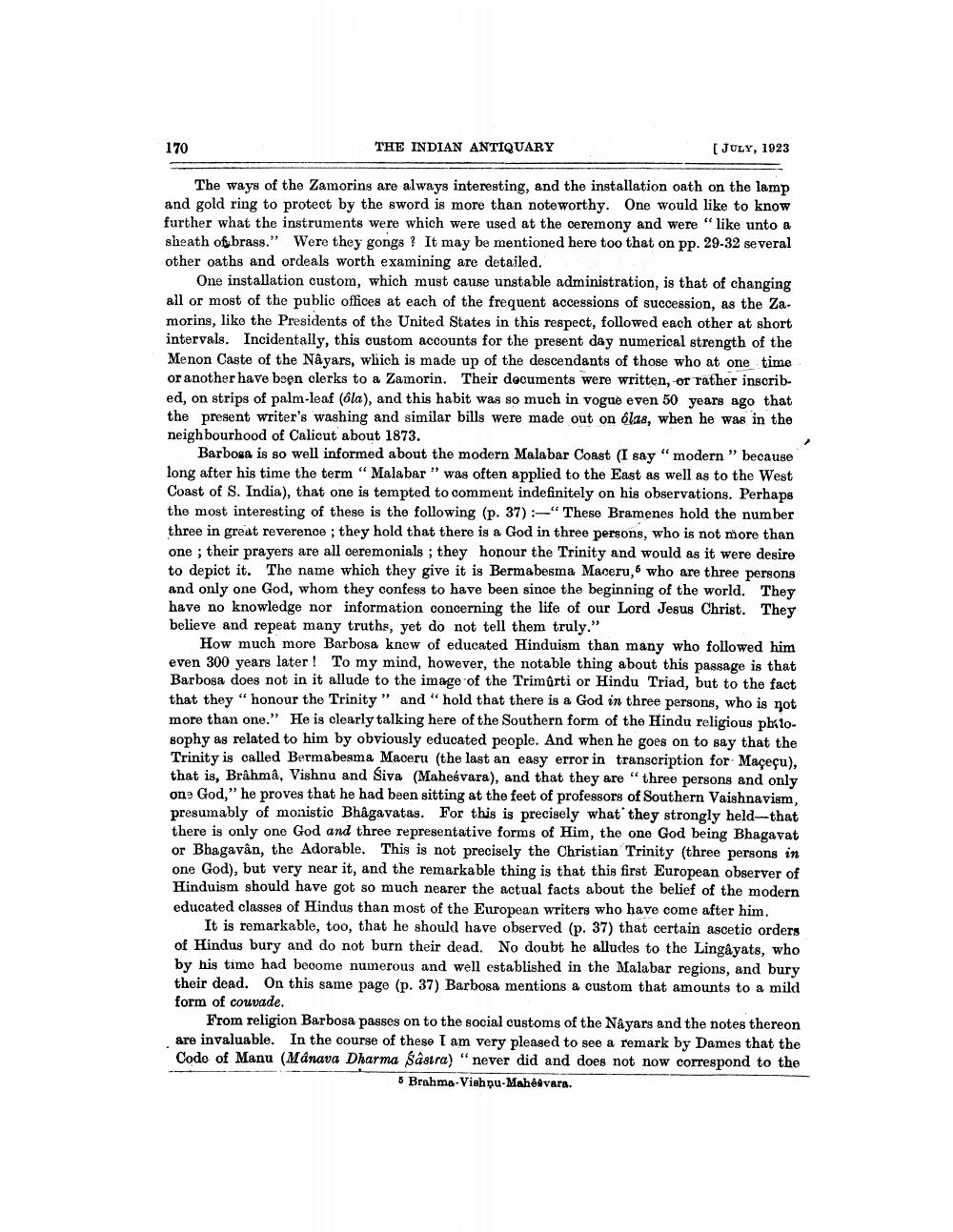________________
THE INDIAN ANTIQUARY
[JULY, 1923
The ways of the Zamorins are always interesting, and the installation oath on the lamp and gold ring to protect by the sword is more than noteworthy. One would like to know further what the instruments were which were used at the ceremony and were "like unto a sheath of brass." Were they gongs? It may be mentioned here too that on pp. 29-32 several other oaths and ordeals worth examining are detailed.
One installation custom, which must cause unstable administration, is that of changing all or most of the public offices at each of the frequent accessions of succession, as the Zamorins, like the Presidents of the United States in this respect, followed each other at short intervals. Incidentally, this custom accounts for the present day numerical strength of the Menon Caste of the Nâyars, which is made up of the descendants of those who at one time or another have been clerks to a Zamorin. Their documents were written, or rather inscribed, on strips of palm-leaf (ôla), and this habit was so much in vogue even 50 years ago that the present writer's washing and similar bills were made out on olas, when he was in the neighbourhood of Calicut about 1873.
Barbosa is so well informed about the modern Malabar Coast (I say "modern" because long after his time the term "Malabar " was often applied to the East as well as to the West Coast of S. India), that one is tempted to comment indefinitely on his observations. Perhaps the most interesting of these is the following (p. 37):-"These Bramenes hold the number three in great reverence; they hold that there is a God in three persons, who is not more than one; their prayers are all ceremonials; they honour the Trinity and would as it were desire to depict it. The name which they give it is Bermabesma Maceru," who are three persons and only one God, whom they confess to have been since the beginning of the world. They have no knowledge nor information concerning the life of our Lord Jesus Christ. They believe and repeat many truths, yet do not tell them truly."
How much more Barbosa knew of educated Hinduism than many who followed him even 300 years later! To my mind, however, the notable thing about this passage is that Barbosa does not in it allude to the image of the Trimûrti or Hindu Triad, but to the fact that they "honour the Trinity" and "hold that there is a God in three persons, who is not more than one." He is clearly talking here of the Southern form of the Hindu religious philosophy as related to him by obviously educated people. And when he goes on to say that the Trinity is called Bermabesma Maceru (the last an easy error in transcription for Maçeçu), that is, Brahmâ, Vishnu and Siva (Maheśvara), and that they are "three persons and only one God," he proves that he had been sitting at the feet of professors of Southern Vaishnavism, presumably of monistic Bhagavatas. For this is precisely what they strongly held--that there is only one God and three representative forms of Him, the one God being Bhagavat or Bhagavân, the Adorable. This is not precisely the Christian Trinity (three persons in one God), but very near it, and the remarkable thing is that this first European observer of Hinduism should have got so much nearer the actual facts about the belief of the modern educated classes of Hindus than most of the European writers who have come after him.
It is remarkable, too, that he should have observed (p. 37) that certain ascetic orders of Hindus bury and do not burn their dead. No doubt he alludes to the Lingayats, who by his time had become numerous and well established in the Malabar regions, and bury their dead. On this same page (p. 37) Barbosa mentions a custom that amounts to a mild form of couvade.
170
From religion Barbosa passes on to the social customs of the Nayars and the notes thereon are invaluable. In the course of these I am very pleased to see a remark by Dames that the Code of Manu (Mânava Dharma Sâstra) "never did and does not now correspond to the 5 Brahma-Vishpu-Mahêêvara.




